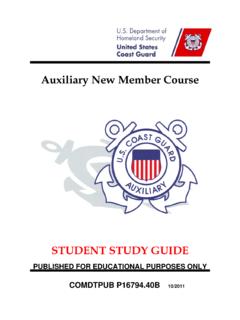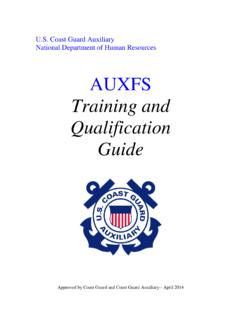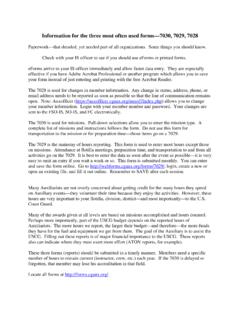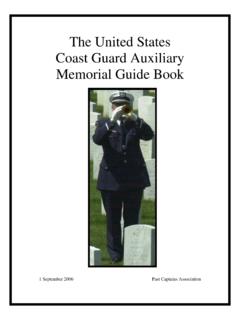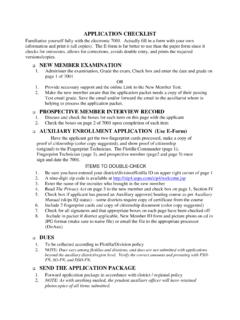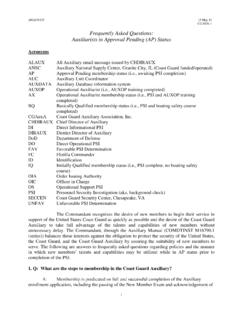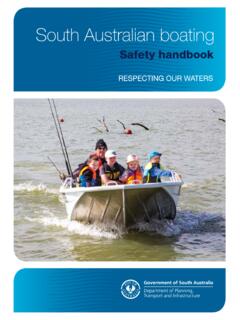Transcription of New Member Reference Guide - CGAUX
1 United States Coast Guard Auxiliary New Member Reference Guide Coast Guard Auxiliary Human Resources Directorate Revised Date: October 2013. Foreword From the National Commodore The Coast Guard is pleased to present the New Member Reference Guide to every potential, and new Member of the Coast Guard Auxiliary. The Prologue to the Membership Pledge states that you have been brought into: .. an organization dedicated to the promotion of boating safety and providing assistance to the Coast Guard in the fulfillment of its civil functions. You accept this membership as a volunteer, but as a Member you are charged with certain responsibilities and obligations. These include your willingness to support the Coast Guard Auxiliary and its purposes and to participate in its authorized programs to the best of your ability and to the extent that time and circumstances permit.
2 There are many other opportunities for service within the Auxiliary. Select the activity that interests you the most. Your flotilla has many interesting ways in which you can participate. We need your help and are looking forward to your participation. The personal benefits and satisfaction that you receive from your membership will depend upon your choices and level of involvement. The Auxiliary Manual (COMDTINST series) serves as the primary policy Guide for the administration and management of the Auxiliary. It outlines the duties, responsibilities, and expectations of Auxiliarists as they continue to deliver vital services and assist the Coast Guard in shaping, preparing, and applying its mission capability through the 21st century. You may have already received your Auxiliary Manual (available on your New Member CD).
3 This is the first of many manuals and other publications that you will be able to obtain as a Member of the Auxiliary. Your membership in this organization will be enhanced by the information contained in them. It is important for all members to read their manuals and keep them updated. This Reference Guide is neither intended to replace nor supplant the Auxiliary Manual, but rather serve as an abridged resource document for new members. In the event of any discrepancy, the Auxiliary Manual is the governing document. We extend our deep gratitude to the extraordinary Auxiliarists and Coast Guard service members, and we wish you all the best as you carry out your duties and responsibilities in support of the Coast Guard and the Nation. Your continued support and dedication are greatly appreciated.
4 Semper Paratus! THOMAS C. MALLISON /s/. National Commodore Coast Guard Auxiliary New Member Reference Guide TABLE OF CONTENTS. CHAPTER 1 - HISTORY, PURPOSE, & ADMINISTRATION .. 1. CHAPTER 2 - MISSIONS & PROGRAMS .. 3. CHAPTER 3 - MEMBERSHIP .. 6. CHAPTER 4 - AUXILIARY ORGANIZATIONAL STRUCTURE .. 16. CHAPTER 5 - REGULATIONS & 23. CHAPTER 6 SUPPORT & BASIC MATERIALS .. 34. CHAPTER 7 - HUMAN 37. CHAPTER 8 - Member TRAINING & QUALIFICATIONS .. 42. CHAPTER 9 - REIMBURSEMENT OF AUXILIARISTS .. 47. CHAPTER 10 - UNIFORMS .. 49. CHAPTER 11 - AUXILIARIST RECOGNITIONS/AWARDS .. 66. CHAPTER 12 - Guide TO CUSTOMS, COURTESY, & 71. APPENDIX A Reference MATERIALS .. 73. APPENDIX B - ACRONYMS .. 77. i New Member Reference Guide CHAPTER 1 - HISTORY, PURPOSE, & ADMINISTRATION. Section A.
5 Creation of the Auxiliary In 1939, Congress established a Coast Guard Reserve administered by the Commandant and composed of unpaid, volunteer citizens who owned motorboats or yachts. In 1941, Congress created a military Reserve and renamed the original volunteer Reserve as the Coast Guard Auxiliary. The Coast Guard is a military service and is a component of the Armed Forces. The Coast Guard Auxiliary is a component of Coast Guard Forces like the active duty, Reserve, and civilian components. Thus, the Auxiliary may be referred to and considered to be included under the general organizational umbrella of the Coast Guard. Auxiliarists are not contractually bound, enlisted, or commissioned officers, but are volunteers pledged to serve in the Coast Guard Auxiliary. The Coast Guard is also charged with many civil responsibilities in addition to its military missions.
6 In contrast to Coast Guard active duty personnel and Reserve military components, the Auxiliary is specifically declared by statute to be non-military. This definition puts the Auxiliary's role entirely within the Coast Guard's civil function responsibilities. The Auxiliary's role does not extend to any Coast Guard military or direct law enforcement missions assigned to active or Reserve forces. The Commandant's administrative authority further defines the Auxiliary's role. The Commandant determines how the Auxiliary may assist in performing Coast Guard civil missions. The Commandant also determines how the Auxiliary may assist the Coast Guard by prescribing training and qualifications necessary to provide this assistance and to perform such activities. Section B. Coast Guard Leadership & Management Title 14 provides for a single organization to be the Coast Guard Auxiliary.
7 The Commandant has provided for units (districts, divisions, flotillas, detachments, etc.) of the Auxiliary for efficient administrative management. These units are not independent organizational entities and, therefore, are required to follow and comply with the policies and procedures established by the Commandant as set forth in this Manual and other Commandant instructions applicable to the Auxiliary. They must also comply with such policies, procedures, and standing rules established by higher-level organizational units in the Auxiliary chain of leadership and management. The organizational units may not change, add, or delete requirements for service or processes for operation and administration of the Auxiliary at any level without the prior authorization of the Auxiliary National Board, National Commodore (NACO), and Chief Director, Auxiliary (Chief Director).
8 1. New Member Reference Guide The Commandant (CCG), as the Coast Guard's senior officer, is responsible for administering the service in an economical and efficient manner. The Commandant prescribes broad policies for governing the service, and directs, supervises, and coordinates service endeavors and performance. The Commandant guides the Coast Guard legislative programs and requires compliance with the statutory obligations and requirements imposed. Finally, the Commandant establishes and maintains liaison with other Federal Government agencies and with the public. Under the general direction and supervision of the Commandant, the Chief Director of Auxiliary directs the Coast Guard Auxiliary administration and also serves as Executive Director of the National boating safety Advisory Council (NBSAC).
9 Section C. Auxiliary Leadership & Management Under Coast Guard administration, Auxiliarists are organized into the following four unit levels of administrative and supervisory responsibility: a. Flotilla b. Division c. District/Region d. National Auxiliary leaders responsible for unit administration and supervision are elected at each level. These elected Auxiliary leaders in turn appoint appropriate staff officers to carry out Auxiliary missions and programs Section D. Coast Guard Auxiliary Linkage with the Coast Guard The National Commodore (NACO) is the senior and principal officer of the Auxiliary. The NACO represents the Auxiliary and reports to the Commandant through the Vice Commandant (VCG). Additionally, the NACO represents the Auxiliary with all Coast Guard Flag officers and Flag officer equivalent civilians at Coast Guard Headquarters on Auxiliary matters.
10 The NACO functions to support the Commandant's strategic goals and objectives and serve Auxiliarists. 2. New Member Reference Guide CHAPTER 2 - MISSIONS & PROGRAMS. The Commandant has assigned primary responsibility for the accomplishment of certain missions to the Auxiliary as an organization. This chapter outlines those mission areas in which the Commandant has authorized Auxiliarists, as individuals, to participate in the mission areas specifically assigned to the Auxiliary. Together, the missions assigned to the Auxiliary and the mission areas authorized for individual Auxiliarist participation are essential and basic to operating the Auxiliary and effectively using Auxiliarists to successfully support and accomplish the missions of the Coast Guard. Section A. Missions and Unit Goals With the passage of the Auxiliary legislation in October 1996, the Auxiliary's role was greatly expanded to enable Auxiliary participation in any Coast Guard mission authorized by the Commandant.
